Related Research Articles
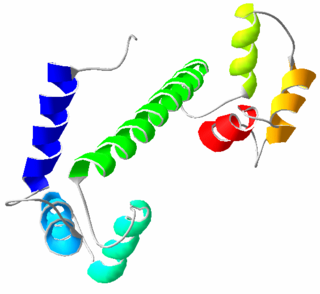
Calmodulin (CaM) (an abbreviation for calcium-modulated protein) is a multifunctional intermediate calcium-binding messenger protein expressed in all eukaryotic cells. It is an intracellular target of the secondary messenger Ca2+, and the binding of Ca2+ is required for the activation of calmodulin. Once bound to Ca2+, calmodulin acts as part of a calcium signal transduction pathway by modifying its interactions with various target proteins such as kinases or phosphatases.
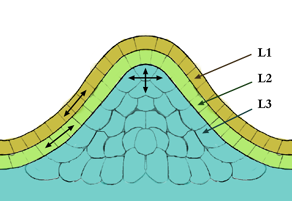
The meristem is a type of tissue found in plants. It consists of undifferentiated cells capable of cell division. Cells in the meristem can develop into all the other tissues and organs that occur in plants. These cells continue to divide until a time when they get differentiated and then lose the ability to divide.

Cytokinins (CK) are a class of plant hormones that promote cell division, or cytokinesis, in plant roots and shoots. They are involved primarily in cell growth and differentiation, but also affect apical dominance, axillary bud growth, and leaf senescence. Folke Skoog discovered their effects using coconut milk in the 1940s at the University of Wisconsin–Madison.
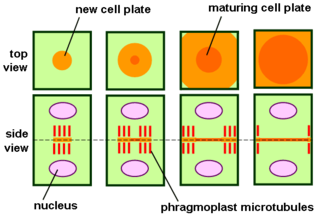
The phragmoplast is a plant cell specific structure that forms during late cytokinesis. It serves as a scaffold for cell plate assembly and subsequent formation of a new cell wall separating the two daughter cells. The phragmoplast can only be observed in Phragmoplastophyta, a clade that includes the Coleochaetophyceae, Zygnematophyceae, Mesotaeniaceae, and Embryophyta. Some algae use another type of microtubule array, a phycoplast, during cytokinesis.
Florigen is the hypothesized hormone-like molecule responsible for controlling and/or triggering flowering in plants. Florigen is produced in the leaves, and acts in the shoot apical meristem of buds and growing tips. It is known to be graft-transmissible, and even functions between species. However, despite having been sought since the 1930s, the exact nature of florigen is still disputed.
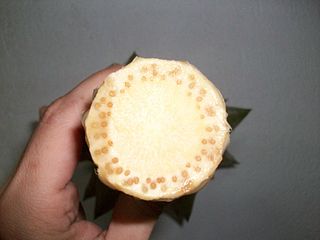
A primordium in embryology, is an organ or tissue in its earliest recognizable stage of development. Cells of the primordium are called primordial cells. A primordium is the simplest set of cells capable of triggering growth of the would-be organ and the initial foundation from which an organ is able to grow. In flowering plants, a floral primordium gives rise to a flower.
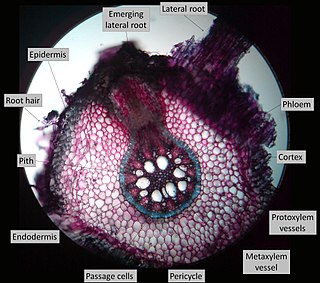
Lateral roots, emerging from the pericycle, extend horizontally from the primary root (radicle) and over time makeup the iconic branching pattern of root systems. They contribute to anchoring the plant securely into the soil, increasing water uptake, and facilitates the extraction of nutrients required for the growth and development of the plant. Lateral roots increase the surface area of a plant's root system and can be found in great abundance in several plant species. In some cases, lateral roots have been found to form symbiotic relationships with rhizobia (bacteria) and mycorrhizae (fungi) found in the soil, to further increase surface area and increase nutrient uptake.

Systemin is a plant peptide hormone involved in the wound response in the family Solanaceae. It was the first plant hormone that was proven to be a peptide having been isolated from tomato leaves in 1991 by a group led by Clarence A. Ryan. Since then, other peptides with similar functions have been identified in tomato and outside of the Solanaceae. Hydroxyproline-rich glycopeptides were found in tobacco in 2001 and AtPEPs were found in Arabidopsis thaliana in 2006. Their precursors are found both in the cytoplasm and cell walls of plant cells, upon insect damage, the precursors are processed to produce one or more mature peptides. The receptor for systemin was first thought to be the same as the brassinolide receptor but this is now uncertain. The signal transduction processes that occur after the peptides bind are similar to the cytokine-mediated inflammatory immune response in animals. Early experiments showed that systemin travelled around the plant after insects had damaged the plant, activating systemic acquired resistance, now it is thought that it increases the production of jasmonic acid causing the same result. The main function of systemins is to coordinate defensive responses against insect herbivores but they also affect plant development. Systemin induces the production of protease inhibitors which protect against insect herbivores, other peptides activate defensins and modify root growth. They have also been shown to affect plants' responses to salt stress and UV radiation. AtPEPs have been shown to affect resistance against oomycetes and may allow A. thaliana to distinguish between different pathogens. In Nicotiana attenuata, some of the peptides have stopped being involved in defensive roles and instead affect flower morphology.

Wall-associated kinases (WAKs) are one of many classes of plant proteins known to serve as a medium between the extracellular matrix (ECM) and cytoplasm of cell walls. They are serine-threonine kinases that contain epidermal growth factor (EGF) repeats, a cytoplasmic kinase and are located in the cell walls. They provide a linkage between the inner and outer surroundings of cell walls. WAKs are under a group of receptor-like kinases (RLK) that are actively involved in sensory and signal transduction pathways especially in response to foreign attacks by pathogens and in cell development. On the other hand, pectins are an abundant group of complex carbohydrates present in the primary cell wall that play roles in cell growth and development, protection, plant structure and water holding capacity.

In the field of molecular biology, a two-component regulatory system serves as a basic stimulus-response coupling mechanism to allow organisms to sense and respond to changes in many different environmental conditions. Two-component systems typically consist of a membrane-bound histidine kinase that senses a specific environmental stimulus and a corresponding response regulator that mediates the cellular response, mostly through differential expression of target genes. Although two-component signaling systems are found in all domains of life, they are most common by far in bacteria, particularly in Gram-negative and cyanobacteria; both histidine kinases and response regulators are among the largest gene families in bacteria. They are much less common in archaea and eukaryotes; although they do appear in yeasts, filamentous fungi, and slime molds, and are common in plants, two-component systems have been described as "conspicuously absent" from animals.

Histidine kinases (HK) are multifunctional, and in non-animal kingdoms, typically transmembrane, proteins of the transferase class of enzymes that play a role in signal transduction across the cellular membrane. The vast majority of HKs are homodimers that exhibit autokinase, phosphotransfer, and phosphatase activity. HKs can act as cellular receptors for signaling molecules in a way analogous to tyrosine kinase receptors (RTK). Multifunctional receptor molecules such as HKs and RTKs typically have portions on the outside of the cell that bind to hormone- or growth factor-like molecules, portions that span the cell membrane, and portions within the cell that contain the enzymatic activity. In addition to kinase activity, the intracellular domains typically have regions that bind to a secondary effector molecule or complex of molecules that further propagate signal transduction within the cell. Distinct from other classes of protein kinases, HKs are usually parts of a two-component signal transduction mechanisms in which HK transfers a phosphate group from ATP to a histidine residue within the kinase, and then to an aspartate residue on the receiver domain of a response regulator protein. More recently, the widespread existence of protein histidine phosphorylation distinct from that of two-component histidine kinases has been recognised in human cells. In marked contrast to Ser, Thr and Tyr phosphorylation, the analysis of phosphorylated Histidine using standard biochemical and mass spectrometric approaches is much more challenging, and special procedures and separation techniques are required for their preservation alongside classical Ser, Thr and Tyr phosphorylation on proteins isolated from human cells.

Phototropism is the growth of an organism in response to a light stimulus. Phototropism is most often observed in plants, but can also occur in other organisms such as fungi. The cells on the plant that are farthest from the light have a chemical called auxin that reacts when phototropism occurs. This causes the plant to have elongated cells on the furthest side from the light. Phototropism is one of the many plant tropisms or movements which respond to external stimuli. Growth towards a light source is called positive phototropism, while growth away from light is called negative phototropism. Negative phototropism is not to be confused with skototropism which is defined as the growth towards darkness, whereas negative phototropism can refer to either the growth away from a light source or towards the darkness. Most plant shoots exhibit positive phototropism, and rearrange their chloroplasts in the leaves to maximize photosynthetic energy and promote growth. Some vine shoot tips exhibit negative phototropism, which allows them to grow towards dark, solid objects and climb them. The combination of phototropism and gravitropism allow plants to grow in the correct direction.

A response regulator is a protein that mediates a cell's response to changes in its environment as part of a two-component regulatory system. Response regulators are coupled to specific histidine kinases which serve as sensors of environmental changes. Response regulators and histidine kinases are two of the most common gene families in bacteria, where two-component signaling systems are very common; they also appear much more rarely in the genomes of some archaea, yeasts, filamentous fungi, and plants. Two-component systems are not found in metazoans.
BRI1-associated receptor kinase 1 is an important plant protein that has diverse functions in plant development.

Histidine phosphotransfer domains and histidine phosphotransferases are protein domains involved in the "phosphorelay" form of two-component regulatory systems. These proteins possess a phosphorylatable histidine residue and are responsible for transferring a phosphoryl group from an aspartate residue on an intermediate "receiver" domain, typically part of a hybrid histidine kinase, to an aspartate on a final response regulator.
Pseudo-response regulator (PRR) refers to a group of genes that are important in the plant circadian oscillator. There are four primary PRR proteins that perform the majority of interactions with other proteins within the circadian oscillator, and another (PRR3) that has limited function. These genes are all paralogs of each other, and all repress the transcription of Circadian Clock Associated 1 (CCA1) and Late Elongated Hypocotyl (LHY) at various times throughout the day. The expression of PRR9, PRR7, PRR5 and TOC1/PRR1 peak around morning, mid-day, afternoon and evening, respectively. As a group, these genes are one part of the three-part repressilator system that governs the biological clock in plants.
Botrytis–induced kinase 1 (BIK1) is a membrane-anchored enzyme in plants. It is a kinase that provides resistance to necrotrophic and biotrophic pathogens. As its name suggests, BIK1 is only active after being induced by Botrytis infection. When Botrytis cinerea is present, the BIK1 gene is transcribed so that the kinase is present to defend the cell. BIK1 functions to regulate the amount of salicylic acid (SA) present in the cell. When Botrytis cinerea or Alternaria brassicicola or any other necrotrophic pathogen is present, BIK1 is transcribed to regulate the pathogen response mechanisms. When BIK1 is present, SA levels decrease, allowing the nectrotrophic response to take place. When nectrotrophic pathogens are not present, BIK1 is not transcribed and SA levels increase, limiting the necrotrophic resistance pathway. Only the pathogenic defense response that is initiated by BIK1 is dependent on SA levels. Non-pathogenic cellular functions occur independently. In terms of non-pathogenic cellular functions, BIK1 is described as a critical component of ET signaling and PAMP-triggered immunity to pathogens.
Feronia, also known as FER or protein Sirene, is a recognition receptor kinase found in plants. FER plays a significant part in the plant immune system as a receptor kinase which assists in immune signaling within plants, plant growth, and plant reproduction. FER is regulated by the Rapid Alkalinization Factor (RALF). FER regulates growth in normal environments but it is most beneficial in stressful environments as it helps to initiate immune signaling. FER can also play a role in reproduction in plants by participating in the communication between the female and male cells. FER is found in and can be studied in the organism Arabidopsis thaliana.
Hydraulic signals in plants are detected as changes in the organism's water potential that are caused by environmental stress like drought or wounding. The cohesion and tension properties of water allow for these water potential changes to be transmitted throughout the plant.

Ethylene signaling pathway is a signal transduction in plant cells to regulate important growth and developmental processes. Acting as a plant hormone, the gas ethylene is responsible for promoting the germination of seeds, ripening of fruits, the opening of flowers, the abscission of leaves and stress responses. It is the simplest alkene gas and the first gaseous molecule discovered to function as a hormone.
References
- 1 2 3 4 5 6 Kang NY, Cho C, Kim J (November 2013). "Inducible expression of Arabidopsis response regulator 22 (ARR22), a type-C ARR, in transgenic Arabidopsis enhances drought and freezing tolerance". PLOS ONE. 8 (11): e79248. doi: 10.1371/journal.pone.0079248 . PMC 3828410 . PMID 24244460.
- 1 2 3 4 5 6 7 8 9 10 11 Ferreira FJ, Kieber JJ (October 2005). "Cytokinin signaling". Current Opinion in Plant Biology. 8 (5): 518–25. doi:10.1016/j.pbi.2005.07.013. PMID 16054432.
- 1 2 Sakakibara H (2006). "Cytokinins: activity, biosynthesis, and translocation". Annual Review of Plant Biology. 57: 431–49. doi:10.1146/annurev.arplant.57.032905.105231. PMID 16669769.
- ↑ Dello Ioio R, Linhares FS, Scacchi E, Casamitjana-Martinez E, Heidstra R, Costantino P, Sabatini S (April 2007). "Cytokinins determine Arabidopsis root-meristem size by controlling cell differentiation". Current Biology. 17 (8): 678–82. doi: 10.1016/j.cub.2007.02.047 . PMID 17363254.
- 1 2 3 4 5 To JP, Deruère J, Maxwell BB, Morris VF, Hutchison CE, Ferreira FJ, Schaller GE, Kieber JJ (December 2007). "Cytokinin regulates type-A Arabidopsis Response Regulator activity and protein stability via two-component phosphorelay". The Plant Cell. 19 (12): 3901–14. doi:10.1105/tpc.107.052662. PMC 2217641 . PMID 18065689.
- 1 2 Kang NY, Cho C, Kim NY, Kim J (September 2012). "Cytokinin receptor-dependent and receptor-independent pathways in the dehydration response of Arabidopsis thaliana". Journal of Plant Physiology. 169 (14): 1382–91. doi:10.1016/j.jplph.2012.05.007. PMID 22704545.
- 1 2 3 4 Hutchison CE, Li J, Argueso C, Gonzalez M, Lee E, Lewis MW, Maxwell BB, Perdue TD, Schaller GE, Alonso JM, Ecker JR, Kieber JJ (November 2006). "The Arabidopsis histidine phosphotransfer proteins are redundant positive regulators of cytokinin signaling". The Plant Cell. 18 (11): 3073–87. doi:10.1105/tpc.106.045674. PMC 1693944 . PMID 17122069.
- ↑ Schaller GE, Doi K, Hwang I, Kieber JJ, Khurana JP, Kurata N, Mizuno T, Pareek A, Shiu SH, Wu P, Yip WK (February 2007). "Nomenclature for two-component signaling elements of rice". Plant Physiology. 143 (2): 555–7. doi:10.1104/pp.106.093666. PMC 1803756 . PMID 17284581.
- ↑ To JP, Haberer G, Ferreira FJ, Deruère J, Mason MG, Schaller GE, Alonso JM, Ecker JR, Kieber JJ (March 2004). "Type-A Arabidopsis response regulators are partially redundant negative regulators of cytokinin signaling". The Plant Cell. 16 (3): 658–71. doi:10.1105/tpc.018978. PMC 385279 . PMID 14973166.
- 1 2 Salomé PA, To JP, Kieber JJ, McClung CR (January 2006). "Arabidopsis response regulators ARR3 and ARR4 play cytokinin-independent roles in the control of circadian period". The Plant Cell. 18 (1): 55–69. doi:10.1105/tpc.105.037994. PMC 1323484 . PMID 16326927.
- ↑ Bacete, L; Mélida, H; López, G; Dabos, P; Tremousaygue, D; Denancé, N; Miedes, E; Bulone, V; Goffner, D; Molina, A (12 Mar 2020). "Arabidopsis Response Regulator 6 (ARR6) Modulates Plant Cell-Wall Composition and Disease Resistance". Molecular Plant-Microbe Interactions. 33 (5): 767–780. doi: 10.1094/MPMI-12-19-0341-R . PMID 32023150.
- 1 2 3 4 5 Argyros RD, Mathews DE, Chiang YH, Palmer CM, Thibault DM, Etheridge N, Argyros DA, Mason MG, Kieber JJ, Schaller GE (August 2008). "Type B response regulators of Arabidopsis play key roles in cytokinin signaling and plant development". The Plant Cell. 20 (8): 2102–16. doi:10.1105/tpc.108.059584. PMC 2553617 . PMID 18723577.
- 1 2 3 4 Mason MG, Li J, Mathews DE, Kieber JJ, Schaller GE (June 2004). "Type-B response regulators display overlapping expression patterns in Arabidopsis". Plant Physiology. 135 (2): 927–37. doi:10.1104/pp.103.038109. PMC 514127 . PMID 15173562.